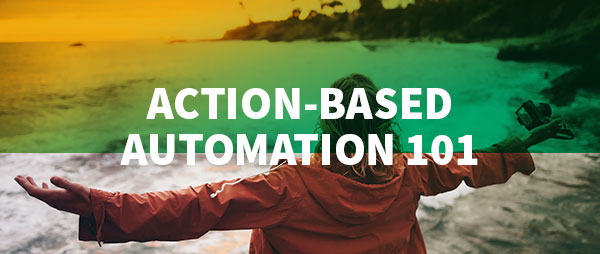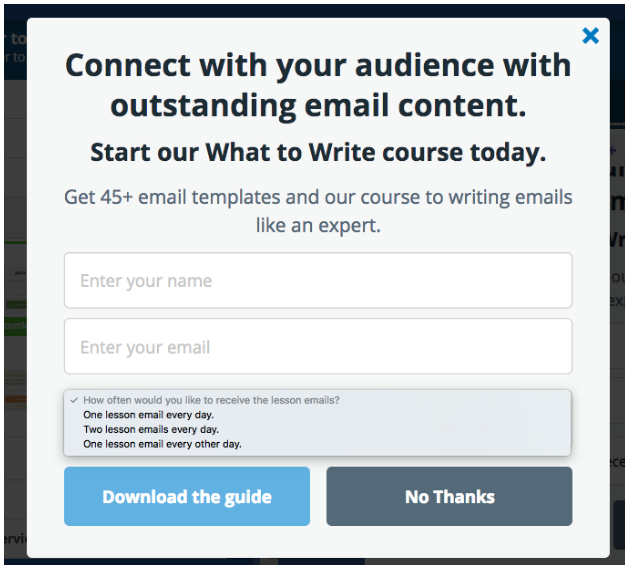
What is email automation?
Simply put, email automation is when you set up a series of emails to send automatically to subscribers at a specific time. With it, you can connect with a person at every stage of their buyer journey (a.k.a. the marketing funnel) — from lead to customer to brand advocate. You can build a relationship with an individual over the long term. And the best part? It runs on autopilot, creating connections and increasing revenue while you work on other aspects of your business. You can set up a single series automation — where a person subscribes to your list and is automatically sent email 1, then email 2, then email 3, etc. in a sequence. Or you can set up a series with action-based automation.What is action-based automation?
I like to think of action-based automation as letting your subscribers “choose their own adventure” as they’re taken through your email sequence. Instead of automatically sending everyone on your list the same series (email 1, email 2, email 3, etc.), each individual subscriber gets to pick which emails they’re sent through various actions they take. While it’s more advanced than a single automation series, action-based automation can skyrocket engagement and sales. That's because you are able to target segments of our audience with the exact content they needed. It's an amazing feeling when you can put a solution right in the hands of your subscribers. So how do you implement action-based automation?3 ways to get started with action-based automation
 Here’s another example: A personal trainer asks his subscriber to choose her level of strength training — beginner, intermediate, or advanced — on his sign up form. Once the subscriber makes her selection, she’s instantly dropped into an automated series that aligns with her training experience. The language and work out tips in each message are tailored to her personal workout level. For instance, a beginner subscriber who is new to strength training may receive fundamental tips like how many reps are best for building muscle, how much they should rest between sets, or which shoes they should wear while lifting. Whereas an intermediate may get an email series that focuses on variations of standard strength exercises to challenge their muscles in an all-new way or mobility movements to keep their joints healthy between lifting sessions. And an advanced subscriber may learn the ins-and-outs of a cutting-edge technique called Blood Flow Restriction training to shock the muscles into new growth. If each flow is tailored to a person’s level, you can send them more personalized messaging to promote your product as opposed to a one-size-fits-all plan like a single automated series that's sent to everyone on your list. After all, it's tough to write to an entire crowd. By accommodating everyone, you're not catering to anyone. Think about it: an advanced strength trainer would be bored to death with beginner content. And a beginner would be overwhelmed with advanced techniques. That's why action-based automation can help you send content appropriate for each group. Pro tip: Your email marketing platform will launch your automated campaign based off tages or custom fields determined by your sign up form. That means you should stay away from fill-in-the-blank responses. Instead, go with pre-populated field that your subscribers can choose from. (It’s easy to create a sign up dropdown menu in an ESP like AWeber, or there are many signup form platforms that integrate with your ESP. Some options are OptinMonster or Privy. No website? Here's how to create a hosted sign up form in less than 5 minutes.)
Here’s another example: A personal trainer asks his subscriber to choose her level of strength training — beginner, intermediate, or advanced — on his sign up form. Once the subscriber makes her selection, she’s instantly dropped into an automated series that aligns with her training experience. The language and work out tips in each message are tailored to her personal workout level. For instance, a beginner subscriber who is new to strength training may receive fundamental tips like how many reps are best for building muscle, how much they should rest between sets, or which shoes they should wear while lifting. Whereas an intermediate may get an email series that focuses on variations of standard strength exercises to challenge their muscles in an all-new way or mobility movements to keep their joints healthy between lifting sessions. And an advanced subscriber may learn the ins-and-outs of a cutting-edge technique called Blood Flow Restriction training to shock the muscles into new growth. If each flow is tailored to a person’s level, you can send them more personalized messaging to promote your product as opposed to a one-size-fits-all plan like a single automated series that's sent to everyone on your list. After all, it's tough to write to an entire crowd. By accommodating everyone, you're not catering to anyone. Think about it: an advanced strength trainer would be bored to death with beginner content. And a beginner would be overwhelmed with advanced techniques. That's why action-based automation can help you send content appropriate for each group. Pro tip: Your email marketing platform will launch your automated campaign based off tages or custom fields determined by your sign up form. That means you should stay away from fill-in-the-blank responses. Instead, go with pre-populated field that your subscribers can choose from. (It’s easy to create a sign up dropdown menu in an ESP like AWeber, or there are many signup form platforms that integrate with your ESP. Some options are OptinMonster or Privy. No website? Here's how to create a hosted sign up form in less than 5 minutes.)
Many times, you’ll plan to send all of your subscribers the same welcome series. By sending the same content, you can educate your prospects on a specific topic or the value of your services and products. Not all subscribers are ready to be segmented from the first email.
If you do that, you can implement Click Automations at the end of the course or sequence of emails. Rather than present your audience with a dead-end, use Click Automations to let subscribers self-select their next step in their customer journey. By presenting options, your audience can choose their own adventure, and enter into a new campaign that meets their needs.
Put action-based automation into action!
Give it a shot. Use one of these 3 techniques to segment your audience so you can send highly-targeted, highly-relevant content to your subscribers. This will help you treat your subscribers as individuals — not a nameless, faceless list. In the long run, you'll see engagement and sales increase, and you'll create a base of fans who can't wait to read your messages. Need help with one of these techniques, or have a question about email automation? Call AWeber's Customer Solutions team. They're the best. Seriously. They won two Stevie Awards in 2017 (a.k.a. the Oscars of the customer service industry). They can help you out with any aspect of your email marketing. Not an AWeber customer? Join our tribe! We'd love for you to try our easy-to-use automation platform for $0. Start your 30-day FREE trial today!The post 3 Simple Ways to Get Started with Action-Based Email Automation appeared first on Email Marketing Tips.
from Email Marketing Tips https://ift.tt/2sIJclF






No comments:
Post a Comment